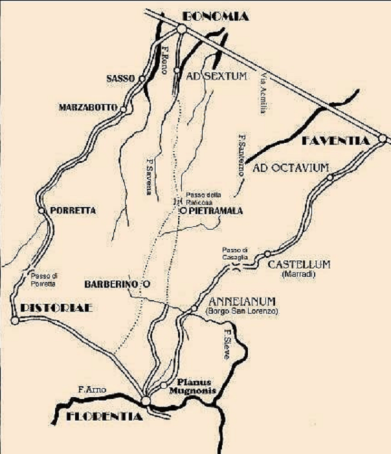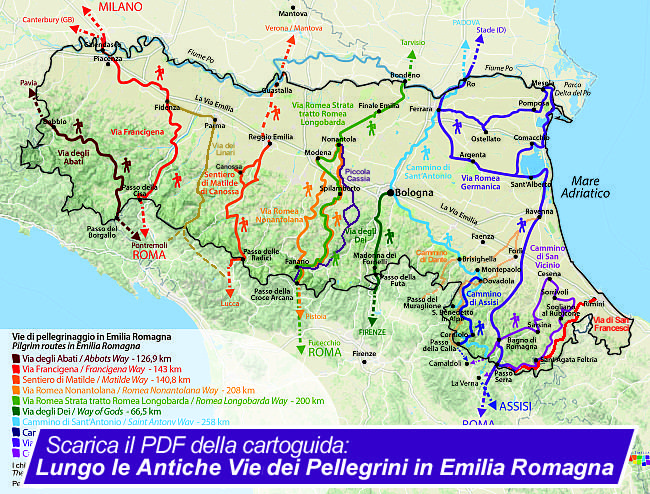This itinerary of the Viae Misericordiae can be inserted into other ancient pilgrim routes:
- Via Romea Germanica, from Pomposa, Comacchio and Anita
- Via Sant’Antonio from Brisighella and Montepaolo
- Via di Dante from oriolo dei fichi and Brisighella
- Cammino di Assisi that starts in Montepaolo www.camminodiassisi.it
- Via Faentina continuing from Gamogna going towards Marradi-Florence
- Other pilgrim routes on the tourist site of the Emilia Romagna region: www.emiliaromagnaturismo.it/it/vie-di-pellegrinaggio/vie-pellegrinaggio-primo-piano.html
Continuing through the Casentinesi forests from Gamogna you can reach the Acquacheta waterfalls in 6 hours, the hermitage of Camaldoli in 18 hours and La Verna in 30 hours.
Emilia Romagna is a land rich in testimonies of faith. They are enclosed in its culture and in the places of prayer from which the religious feeling that has “paved” the streets of the historical-religious itineraries that have traveled through it has spread. For pilgrims, once, these paths were a source of spirituality and the very sign of the culture of hospitality. Today are also the treasures of a map that leads to the soul of the territory. Destinations of religious tourism around which revolve worlds related to art, sustainable and slow experience, tradition and excellence of a region to be discovered.(1)
The roads of the pilgrims
The pilgrim, the homo viator of the Middle Ages, perfectly expresses the human condition; recognizing himself on the way to the kingdom of heaven, from ancient times he was heading towards the places where the enlightening encounter would have occurred, where grace would have been more profuse than elsewhere.
The pilgrim moves to a place that he considers dear and sacred and, when he leaves, he has already arrived with his mind and heart. But it is precisely the journey that makes between home and arrival that will be essential to give the goal that value that will make it a place of joy, and to give the pilgrimage the meaning of a path of penance and moral redemption, of a journey made by devotion, spiritual research.
The Via dei Romei, the heir of the Roman via Popilia
This ancient road connected the regions of Eastern Europe to Rome, also passing from the Adriatic coast. After passing Venice and Ravenna, we entered the Apennines. From Ravenna the medieval pilgrims had different opportunities to continue towards the city of San Pietro. This route also allowed the devotees travelers to reach the embarkations of Puglia for the Holy Land or the Sanctuary of S. Michele on Monte Gargano. The Romei could come from various places of medieval Christianity and, since 784, a letter from the Pope to Charlemagne signaled the existence of a Romei pilgrim shelter in Galeata. During the Middle Ages they traveled along the internal routes, from Ferrara to Faenza, rather than along the coast, which was still unhealthy at the time, finding the comfort and hospitality of the monastic communities they met along the way. The first was the Benedictine one of Pomposa, then – descending – the pilgrims found Comacchio, while towards Ravenna at Sant’Alberto, the homonymous Monastery in Insula Parei was the reference point for those who came to Ravenna.
FROM RAVENNA TO THE APENNINES
Just outside Ravenna, visit the Basilica of Sant’Apollinare in Classe, located in the open countryside: inside are preserved valuable sarcophagi of the fifth and sixth centuries. and magnificent mosaics dating back to the 6th and 7th centuries. The Classe pinewood extends near the Basilica.
After that you can choose to proceed on one side towards Cesena along the Via del Dismano and on the other towards Forlì along the current Ravegnana. Both routes are dotted with ancient country churches.
A further journey, towards the hinterland, leads from the Po Delta to Faenza. It leads first to Ferrara: a break of two or three days allows you to deepen your knowledge of the city of Este. From Ferrara the pilgrims proceeded on foot up to Argenta, then they used boats to reach the southern edge of the marshes.
Along the way meet the Pieve di S. Maria in Fabriago and the Pieve di S. Pietro in Sylvis in Bagnacavallo. Built in the 7th century, it is one of the best preserved churches in the Ravennate area. The dedication refers to the presence of an ancient forest, to which the parish was located. At this point you start to cross the watershed of the Apennines, which offers different opportunities.
ITINERARIES BETWEEN THE VALLI
In Faenza the tourist can visit the MIC, the Duomo, Palazzo Mazzolani, the Cathedral, the Picture Gallery and the Chiesa della Commenda. From the ancient “Faventia”, the traveler can choose three alternatives, according to the Senio, Lamone and Tramazzo valleys.
Reference points of the first route are Riolo Terme and Casola Valsenio, then Palazzuolo in the Tuscan territory. The ancient village of Riolo Terme was already known to the Romans for the healing qualities of its waters; Casola Valsenio presents various attractions: the Rocca di Monte Battaglia, the Officinale Garden and, just 2 Km from the center, the Cardello, perhaps dating back to the 11th century.
The second route starts from Brisighella, where we will visit the thirteenth-century Clock Tower, the Collegiate Church, the Church of the Osservanza (1525), the Rocca Manfrediana and the Veneziana which consists of the so-called “Torrione Veneziano” (XVI century) and of the ancient “Torricino” (1300) and the curious elevated Via del Borgo, otherwise known as Via degli Asini. Even Brisighella is famous, since Roman times, for its thermal waters.
The third route through the Valle del Marzeno has as reference centers Modigliana and Tredozio: the first from the tenth century homeland of the Guidi family and therefore at the center of important historical events, Tredozio was already known at the time of the Romei for the church of San Michele.
From Forlì, three other roads that led the faithful to Tuscany, then to Rome, branched off to the age of the medieval pilgrims: the first crosses the Valle del Montone, touching Terra del Sole and Castrocaro, a renowned thermal center surrounded by greenery; the second one crosses the Valle del Rabbi whose main references are Predappio and Premilcuore; finally the third crosses the Bidente Valley that led to the Mandrioli pass and from here to Arezzo in the Tuscan territory.
(1) source: http://www.emiliaromagnaturismo.it/it/vie-di-pellegrinaggio/vie-pellegrinaggio-primo-piano.html
From Florence to Faenza: via Faventina (faentina)

Built along an ancient Etruscan route – according to some in 150 BC. according to others after the foundation of Florence in 59 BC – it is registered in the Itineriner Antonini (a sort of Roman road network that shows the distances in m.p. between the various places, dating back to the Diocletian period, in the III century AD) on the “via a Faventia – Lucam” route. It was considered to be part of the military road system that from Florence reached as far as Lucca and then to Luni: a sort of road of the two seas that linked the Adriatic and the Tyrrhenian. The Itinerarium starts the consular road from Faenza and therefore also the calculation of the distances (as appears from fig.1), we instead reconstruct the route starting from Florence, from Porta contra Aquilonem, the one to the north, more or less located between the square San Giovanni and via de ‘Cerretani, passed through Borgo San Lorenzo and via San Gallo until it crosses the present via Faentina on the Mugnone torrent. From here, along the valley below Fiesole (which connected it to a secondary road probably corresponding to the steep climb of the Badia Fiesolana) up to the easy summit step the Crosses (519 m) descended along the valley of the Fistona stream to reach the Sieve which crossed near Lutiano (praedium Alitianum), after having touched Salaiole and Gricignano (praedium Graecinianum). With a route located further to the east than that of the current Faentina.
Lino Chini (ancient and modern history of Mugello, Florence 1875) speaks of a road that is certainly “very old military”, referring to even older writings: “traces of the way in the Valcava mountains where the church of San Cresci “(In the place where it is located, most likely there was a pagan temple, the excavations made the foundations found, along with Roman coins including some of the emperor Decius, stones carved with snakes, bones of animals sacrificed and other objects)
After passing the Castellare di Annianum (the modern Borgo San Lorenzo) you start to climb towards Pulicciano (praedium Publicianum) whose church of Santa Maria “the walls of it being the walls of a large cistern built according to Roman use” according to Chini. Just beyond the town of Ronta which preserves many ancient remains of a necropolis and Etruscan-Roman settlements.
The Roman road then leaves the valley of the Elsa stream and passes the Casaglia pass (Casalia in Alpe) to 922 m down the valley of Lamone to Crespino, Fantino and Biforco up to the locality of Castellaccio, near Marradi, where they were found other finds from the Roman era. Probably this is the place reported in the Itinerarium in Castella as an itinerant task.
The road continued along the Lamone valley touching Popolano (praedium Popolanum) S. Cassiano, Casale la Strada, Fognano up to Brisighella and Faenza, the Roman Faventia. There he intersected the Via Emilia.

